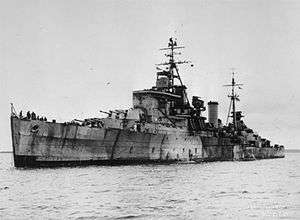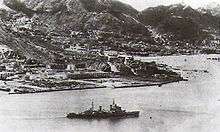HMS Swiftsure (08)
HMS Swiftsure was a Minotaur-class light cruiser of the Royal Navy. She was laid down by Vickers Armstrong at Newcastle-on-Tyne on 22 September 1941, launched on 4 February 1943 by Lady Wake-Walker and commissioned on 22 June 1944. The first of a new Minotaur class, a development of the later Colony class with extra beam and a fifth twin 4 inch turret. Swiftsure was the last Royal Navy cruiser completed during World War Two and was the first British cruiser designed around the concept of an operations room and modern radar, with sensor screens and communications positioned for efficient operation. During her service in the Pacific in 1945, she proved the most efficient anti-aircraft cruiser in the fleet,[1] and was the first Royal Navy cruiser with the 274 lock-and-follow radar targeting system for her main armament
 | |
| History | |
|---|---|
| Name: | HMS Swiftsure |
| Builder: | Vickers Armstrong at Newcastle-on-Tyne |
| Laid down: | 22 September 1941 |
| Launched: | 4 February 1943 |
| Commissioned: | 22 June 1944 |
| Decommissioned: | 1958 |
| Identification: | Pennant number: 08 |
| Fate: | Scrapped 1962 |
| General characteristics | |
| Class and type: | Minotaur-class light cruiser |
| Displacement: |
|
| Length: | 555.5 ft (169.3 m) |
| Beam: | 63 ft (19 m) |
| Draught: | 17.25 ft (5.26 m) |
| Propulsion: |
|
| Speed: | 31.5 kn (58.3 km/h; 36.2 mph) |
| Range: |
|
| Complement: | 867 |
| Armament: |
|
| Armour: | |
Service history
Second World War service

Swiftsure joined the Home Fleet on commissioning, and in 1944 she was assigned to the Eastern Fleet, where, in November 1944, she became a unit of the newly formed British Pacific Fleet. In the Pacific she participated in the Okinawa Campaign of March–May 1945 and in June took part in the carrier raid on Truk by the British Pacific Fleet as part of Task Group 111.2, with the cruisers shelling the islands. On 30 August 1945, this group re-entered Hong Kong and took the Japanese surrender there. Swiftsure was at this time the flagship of the British Pacific Cruiser Squadron, and was selected by Admiral Cecil Harcourt to hoist his flag for the Japanese surrender.
Postwar service
In 1946 she was the flagship of the 4th Cruiser Squadron and in 1951 she became the flagship of the 2nd Cruiser Squadron. Swiftsure was updated for commonality with HMS Superb with 3 glasshouse DC with 275 radar for the 4-inch guns, 960M LRAW and a more powerful 40 mm light AA of Boffin and Buster mounts. Future Formula One world champion Graham Hill served aboard the ship as an engine room artificer around this time.[2] In 1953 she took part in the Fleet Review to celebrate the Coronation of Queen Elizabeth II.[3] On 29 September 1953, she was involved in a collision with the destroyer Diamond leading to a fierce fire in the bridge cable trunk, which carries all the electrical cabling to the bridge, ops room, foremast and DCT. She remained inactive until beginning a major refit in February 1957 at Chatham Dockyard to bring her up largely to the standard of the later Tiger class. New 70 calibre twin 3-inch guns and L70 Bofors would have been fitted, but Swiftsure would have retained her original triple 6 inch turrets. Midway through the conversion in August 1959, with her new bridge and lattice masts in place, the refit was cancelled.[4] Some reports and the government reply in 1962 in UK Hansard say the refit was costing too much to produce an obsolete ship. Original estimates for the refit in 1956 had been 4 million pounds.[5] The damage suffered during her earlier collision with Diamond was not fully surveyed and only became apparent during the refit, which delayed the modernisation, which had been scheduled for completion in December 1959, and after expenditure of more than 1 million pounds,[6] and facing far higher dockyard labour and material costs,[6] modernisation as a gun cruiser was abandoned, although in a rare April 1960 photo of Swiftsure at Chatham dockyard,[7] the three 161-ton Mk 23 turrets (483 tons) are reinstalled and the reconstruction is clearly, partially complete, suggesting the rebuilt hull, had sufficient strength Even with the 6 channel AA fire control system, planned for Swiftsure,[8] which combined, 40 mm and 4-inch fire against specific targets, the twin 4-inch XIX turret updated with roof mounted, tracking radar (as on the cruiser Bermuda and the aircraft carrier Victorious twin 3-inch gun turrets) were still slow firing and manual. Obsolete, compared with the twin 3-inch, or stabilised, enclosed Sverdlov 4 in (105 mm) AA guns, and inaccurate compared with single Mk 5, 55 degree elevation 4.5-inch guns refitted on the C and Type 81 classes from 1955.[9] The Mk 5 twin 40 mm CIWS batteries like the single 1950s Mk 7/9 40mm/60 were much more effective(than WW2 pom pom or Mk 3 Bofors) and still useful against first and second generation jets as the Falkland 1982 war indicated but by 1959, were seen as unfashionable [10] and irrelevant to the expected scenarios of missile, standoff and high level attack. 1959 saw the last fittings of multiple Type 262 radar controlled Mk 5 mounts on Hermes and Belfast.
The refit of Swiftsure was expensively slowed, when the hull was discovered in early 1958 to have compressed more than 18 inches (46 cm) under the weight of a new bridge, there were many stanchions fitted internally below the new bridge to prevent further collapse of the structure, which was similar to that fitted to Belfast, and intended in both cruisers to allow the fitting of data links to the carriers and an operations room which would have included screens for the new Type 965 radar and Type 184 sonar requested by the RN staff in 1957 for Swiftsure and Superb.[11] However the hull was rebuilt in 1958 and by early 1959 the structural reconstruction was complete but the old armament was assessed too obsolete to fit. The option of fitting the new 3-inch twin 70 mm turrets in centreline, 'A', 'B', 'X' and 'Y' positions was possible, but converting the ship from the DC power to AC, for the new guns, added at least another 0.5 million pound cost. Slow progress on debugging new 3-inch/70 calibre guns, which saw the aircraft carrier Victorious armed with slower firing US 3-inch/50 calibre mountings and a storm of opposition in the press and Parliament to the rising cost and slow completion of the cruisers Lion and Blake, saw the surplus 3 in/70 guns sold to Canada and a large order for proximity fused 40 mm L70s cancelled. To finance the immensely expensive completion of the two incomplete Tigers and nip in the bud the intense opposition to 'obsolete cruisers' and new gunnery perceived as faulty, work on Swiftsure's refit stopped. Her sister ship Superb, had been paid off into reserve in late 1957 after 12 years service, her similar modernisation plans abandoned April 1957 and was sold for scrap in early 1960, one of the first Fiji or Improved Minotaurs to be scrapped. Alternative plans for converting Swiftsure to a helicopter carrier were already being considered seriously by 1958,[12]
In November 1960 Swiftsure was still being seriously considered for retention and modernisation with Seaslug missiles as a single-ended conversion or as a helicopter carrier.[6] The Admiralty considered Swiftsure one of its few modern and modernised cruiser hulls and even considered, completely flat decking the cruiser to carry 10–12 helicopters, estimated to cost a prohibitive £7 million pounds[6] and other more limited conversions removing the Y 6-inch turret and retaining just the forward Mk 23 turret,[6] but she was eventually sold, arriving at the Inverkeithing yard of Thos W Ward on 17 October 1962 to be scrapped. Her three 6-inch triple turrets had been removed to reduce top weight for the largely empty hull, for the tow from Chatham to the east coast of Scotland. The helicopter carrier conversion plans however were largely adopted in the late 1960s on the cruisers Blake and Tiger.
References
- N. Freidman. Naval Anti aircraft Guns & Gunnery. Seaforth. Barnsley (2014), (note 46), p. 325.
- http://badgergp.com/graham-hill-the-man-they-called-mister-monaco/
- Souvenir Programme, Coronation Review of the Fleet, Spithead, 15th June 1953, HMSO, Gale and Polden.
- N. Freidman. British Cruisers Two World Wars and After. Seaforth (2010), p. 259.
- Freidman. British Cruisers. (2010), p. 284.
- A. Raven. British Cruisers of World War Two. Arms and Armour (1980), London, p. 365.
- A. Raven. British Cruisers of WW2. Arms and Armour (1980), London, p. 394.
- N. Freidman. British Cruisers. WW2 & After. Seaforth. Barnsley.
- N.Freidman. British Cruisers. Two World Wars & After. (2011)
- Brown & Moore. Redesigning the RN. Seaforth (2012) Barnsley
- N. Freidman. British Cruisers World War 2 and After. Seaforth. Barnsley, UK.
- D. Murfin. AA to AA. The Fiji's Turn Full Circle. Warships (2010), London, p. 56.
Publications
- Colledge, J. J.; Warlow, Ben (2006) [1969]. Ships of the Royal Navy: The Complete Record of all Fighting Ships of the Royal Navy (Rev. ed.). London: Chatham Publishing. ISBN 978-1-86176-281-8.
- WWII cruisers
- HMS Swiftsure at Uboat.net
External links
| Wikimedia Commons has media related to HMS Swiftsure (08). |